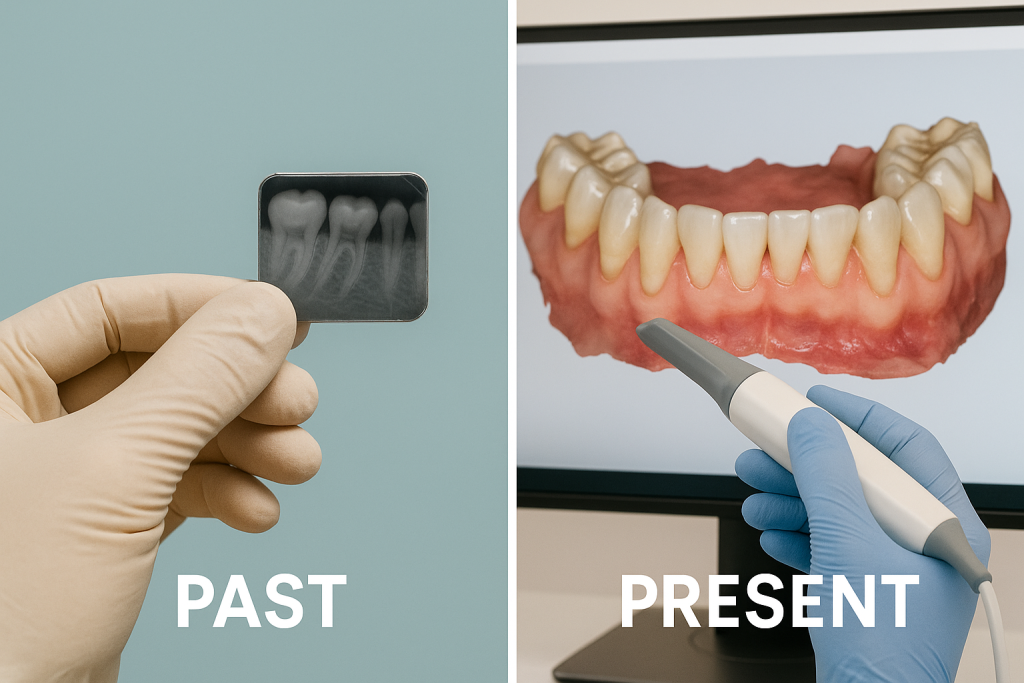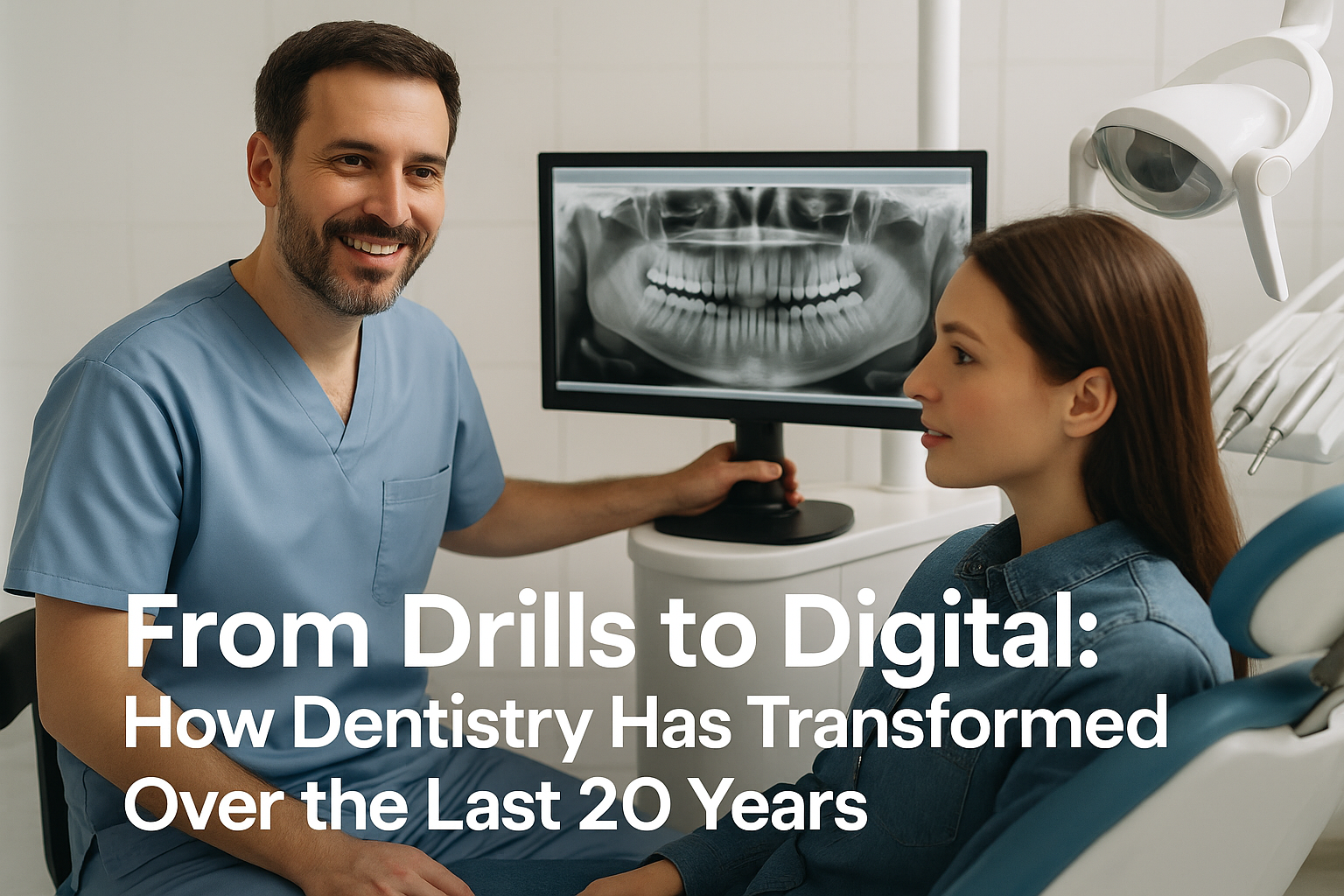Walk into any dental office today and you might be surprised by what you see—or rather, what you don’t see.

No clunky charts stacked in filing cabinets. No film-based X-rays hanging from lightboxes. No “wait-and-see” approach to cavities. And, depending on where you go, maybe even no receptionist at all.
Dentistry has changed. Not slowly. Not quietly. But radically and rapidly over the past 20 years. It’s been a transformation that’s affected how we diagnose, treat, communicate, and even how patients feel when they visit their dentist.
So let’s take a journey. Let’s look back at where dentistry was in the early 2000s and explore how technology, patient expectations, and new ways of thinking have redefined what it means to care for a smile.
1. The Rise of Digital Dentistry
Two decades ago, the typical dental office still ran on paper charts and manual processes. Diagnoses were often based on visual exams, tactile feel, and maybe an X-ray film clipped to a lightbox.
Fast forward to today? We’ve gone digital in nearly every aspect of the practice.
Digital X-rays & 3D Imaging
Gone are the days of waiting for film to develop. Digital radiography allows dentists to capture high-resolution images instantly—and with significantly less radiation. More importantly, 3D cone beam imaging (CBCT) gives clinicians an entirely new way to see the oral environment. It’s become indispensable in placing implants, diagnosing root fractures, and planning orthodontic treatments.
Intraoral Scanners
Say goodbye to goopy impressions. Intraoral scanners now allow dentists to take fast, accurate digital impressions. They improve comfort for the patient, and they create ultra-precise models for crowns, bridges, aligners, and more.
CAD/CAM & Same-Day Dentistry
Using CAD/CAM (computer-aided design and manufacturing), dentists can now design and mill custom restorations—like crowns or veneers—right in the office, sometimes in a single visit. This was unthinkable two decades ago, when lab work could take weeks and required multiple appointments.
2. Cosmetic Dentistry Goes Mainstream
Back in the early 2000s, cosmetic dentistry was still considered somewhat niche—an optional luxury for the rich or famous. Today, it’s a routine part of many practices.
Teeth Whitening & Smile Makeovers
Teeth whitening has exploded in popularity, both in-office and at home. Newer technologies like LED acceleration and more sophisticated whitening gels have made the process faster and more effective.
And it doesn’t stop there. Veneers, bonding, and complete smile makeovers are more accessible than ever, with financing options and patient education driving demand.
Social Media’s Influence
Let’s not forget the impact of Instagram, TikTok, and Zoom. Suddenly, people are hyper-aware of their smiles. Aesthetic dentistry isn’t just about function anymore—it’s about confidence, self-image, and how we present ourselves to the world. That shift in mindset has changed everything.
3. Preventive Care and Minimally Invasive Dentistry
One of the biggest philosophical changes over the past 20 years has been the shift away from reactive dentistry toward prevention and preservation.
Early Detection Tools
Laser cavity detection, digital caries scans, and AI-powered diagnostics now help dentists identify issues before they become serious problems. This means smaller restorations, less drilling, and better outcomes.
Sealants & Fluoride Advances
Fluoride varnishes and high-strength sealants have improved dramatically, offering longer-lasting protection against decay, especially in children.
Minimally Invasive Techniques
Techniques like air abrasion, laser dentistry, and the use of biocompatible materials allow for gentler treatment with less removal of healthy tooth structure.
It’s not just about treating disease anymore—it’s about preserving what’s already healthy.
4. A New Kind of Patient Relationship
Two decades ago, most patients didn’t question their treatment plan. They trusted their dentist’s word, often without needing much explanation. Today? That’s changed—and it’s a good thing.
Patients Are Better Informed
Thanks to the internet and social media, today’s patients come in with research, questions, and expectations. They’re active participants in their care, and they want transparency, options, and to understand why a treatment is necessary.
Communication Is a Two-Way Street
Modern dental practices are leveraging tools like patient portals, email reminders, and even AI chatbots to keep communication flowing. It’s not uncommon for patients to book appointments online, review their treatment plan digitally, and receive follow-up texts after their visit.
Teledentistry Takes Off
While still growing, teledentistry has become an important tool—especially post-pandemic. It allows for consultations, second opinions, and follow-ups to be handled remotely, saving time for both dentist and patient.
5. Business and Office Operations: Smarter, Faster, Leaner
Running a practice in 2005 often meant managing a team to handle insurance paperwork, appointment books, and marketing that usually consisted of a Yellow Pages ad and maybe a mailer.
Today, dental offices are leaner, smarter, and far more automated.
Practice Management Software
Today’s platforms allow for real-time scheduling, insurance verification, electronic billing, and integrated treatment planning. Cloud-based systems are making it easier to manage practices remotely or across multiple locations.
AI Assistants and Automation
From after-hours bots that answer patient questions to AI tools that help diagnose radiographs, artificial intelligence is starting to take the load off busy teams. It’s not about replacing humans—it’s about giving the team more time to focus on personal care and connection.
Online Reputation & Reviews
What used to be word-of-mouth is now digital word-of-mouth. Google reviews, Yelp, and Healthgrades have become vital in attracting and retaining patients. Dentists now have to think about SEO, social media, and branding like never before.
6. Mental Health and Patient Comfort
One of the more subtle but powerful changes in dentistry is the increased awareness around mental health, dental anxiety, and the patient experience.
Comfort-Driven Care
Modern practices are going out of their way to offer amenities like noise-canceling headphones, heated blankets, aromatherapy, and sedation options to reduce fear and anxiety. The goal? Create an experience that feels more like a spa than a sterile clinic.
Trauma-Informed Dentistry
Many dental teams are now trained in trauma-informed care, especially for patients who’ve had negative past experiences or who struggle with PTSD, sensory issues, or autism. This kind of empathetic, patient-centered approach wasn’t part of standard training two decades ago—and it’s making a world of difference.
7. Holistic and Integrative Approaches
Another growing trend is the integration of oral health into the broader wellness conversation.
Airway and Sleep Dentistry
Obstructive sleep apnea, once considered a medical problem, is now firmly in the dental wheelhouse. Dentists trained in sleep medicine are helping patients with oral appliances, diagnostics, and even screening children for signs of airway disorders early on.
Oral-Systemic Health Connections
We now understand the link between oral health and systemic conditions like heart disease, diabetes, and Alzheimer’s. Periodontal treatment is no longer just about saving teeth—it’s about improving overall health.
Biological and Functional Dentistry
While still a niche, biological dentistry is gaining traction. More patients are seeking mercury-free fillings, biocompatible materials, and practices that use ozone therapy, laser detox, or platelet-rich fibrin (PRF) in their treatments.
Where We’re Headed: The Next 20 Years
If the last two decades are any indication, dentistry will continue to evolve in ways we can only imagine. AI diagnostics, regenerative treatments, digital avatars for consultations, smart toothbrushes that sync with your dentist’s dashboard—the future is closer than we think.
But no matter how much tech we embrace, one thing remains constant: the human connection between patient and provider.
At the heart of dentistry is trust, compassion, and care. And while the tools we use may change, the reason we use them does not. We’re still here to ease pain, restore confidence, and help people smile—only now, we’re doing it better than ever.
Final Thoughts
The past 20 years have ushered in an exciting new era of dentistry. We’ve moved from analog to digital, from reactive to preventive, and from clinical to compassionate. Dentists today aren’t just technicians—they’re educators, communicators, and partners in wellness.
For patients, this means faster care, less discomfort, more involvement, and better outcomes. For dental professionals, it means staying curious, embracing change, and never forgetting that the best tool in the operatory is still empathy.
So the next time you recline in that dental chair, take a moment to appreciate just how far we’ve come—and imagine where we’ll go next.

No responses yet